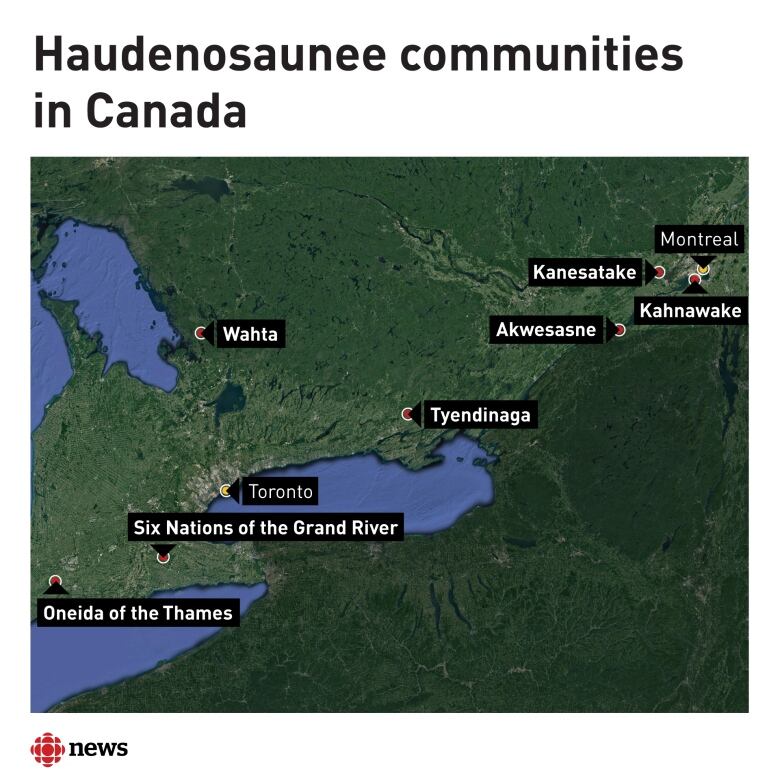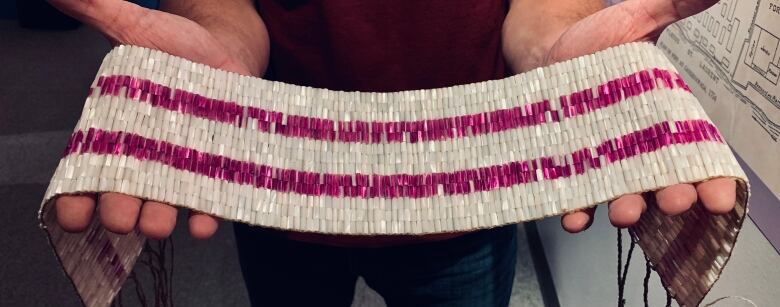Why Haudenosaunee won't be voting in the federal election this October
17th century treaty asserts Iroquois Confederacy are sovereign people, on a parallel track to Canada

While efforts were made during the last federal election to get Indigenous people across Canada to "rock the vote," few Haudenosaunee went out to the polls.
According to data from Elections Canada, 1,851 people voted in the 2015 federal election across all of seven Haudenosaunee communities in Canada. That number represents about 6.6 per cent of eligible voters living on-reserve in those communities.
This October will be no different, saidKenneth Deer, the secretary for the Mohawk Nation at Kahnawake and member of the Haudenosaunee external relations committee.
The reasoning, he said, is political, historicaland fundamental to Haudenosaunee identity.
The Haudenosaunee, or Iroquois, Confederacy includesthe Mohawk, Seneca, Onondaga, Oneida, Cayuga and Tuscarora nations. Seven communities, mostly Mohawk, are located in southern Quebec and Ontario.

"We asMohawks and Haudenosaunee, we don't believe that we are Canadian or American citizens. We believe that we are sovereign people from before contact," said Deer.
He said voting would be a violation of treaty relations established with the Two Row Wampum belt.
What is the Two Row Wampum?

Wampum belts, made of beads from quahog clam shells strung together, are used to symbolize Haudenosaunee laws, traditionsand moments in history. According to the Haudenosaunee Confederacy, theKaswentha, orTwo Row Wampum, dates back to the early 17th century to represent an agreement of peace and mutual respect between the Mohawk nation and the Dutch, the first Europeans they came into contact with.
The agreement was recorded with a belt made ofwhite beads with two parallel rows of purple beads. The white beads represent a river, while the purple rows represent two vessels travelling the river: a ship for the Dutch and a canoe for the Haudenosaunee, each carrying their own laws, traditions, customsand languages.
"The two vessels would go side by side down the river of life and would not interfere with each other," said Deer.

The Two Row Wampum is viewed as a living treaty, and Haudenosaunee continue to use it as a guide for relationships between themselves and other nations to co-exist in peace without interference in the affairs of the other.
"This is worldview for us or how we relate with all governments, whether it's the Dutch or the British or the French, the Americans or Canada," said Deer.
"It's not up to us here in a canoe to decide who steers that ship with sails. By voting in Canadian elections, we areviolating the Two Row relationship that we have with governments."
Numbers don't reflect apathy
In the 2015 election, voter turnout for registered electors living on reserves was 61.5 per cent, an increase of 14 percentage points from the previous election. On Sept. 9, at the release of the Assembly of First Nations's (AFN) 2019 federal election priorities for First Nations, AFN National Chief Perry Bellegarde said he wants that number to increase this year.
Bellegardesaid he never voted in federal elections prior to 2015 but has since embraced a concept of dual citizenship and wants more First Nations people to become politically engaged.

"I was taught as a young boy that we don't have to vote because we have a treaty and it's not our government," said Bellegarde.
"We have to use all the tools in our toolbox or use all the arrows in our quiver to bring out policy and legislative change, and voting is one of them."
Low voter turnouts have been consistent across the Haudenosaunee Confederacy in the last four elections. One year, zero votes were cast at a polling station in Akwesasne, a Mohawk community straddling the Ontario/Quebec and U.S./Canada borders, for the Beauharnois-Salaberry riding.
Courtney Skye, a research fellow at the Yellowhead Institute in Toronto, said the numbers don't reflect apathy. A total of 883 people from her community, Six Nations of the Grand River in southern Ontario, voted in 2015. It's the largest First Nations community in Canada with a membership of over 27,000 and 12,803 who live on-reserve.
"It's a very conscious decision and they recognize the connection between voting and validating settler forms of governance and the importance of the symbolic participation in that," said Skye.
"For a long time we weren't allowed to vote, and now that the vote has been extended, people would rather spend the time in their own communities, developing their own governance, restoring healing from the impact of colonialism, resisting impacts of colonialism than investing time within settler systems."

Kahnawake, a Mohawk community near Montreal, doesn't allow polling stations on-reserve. With anon-reserve population of 7,917, just56 voters participated in the last federal election. For some, the number is still surprisingly high.
"It makes me wonder. Do they know about our history? Do they know about our culture and would they still participate had they been educated and know about these concepts and philosophies?" said Kahsennenhawe Sky-Deer, an elected chief at the Mohawk Council of Kahnawake.
"Anybody who knows what it means to be Haudenosaunee would not put themselves into that ship because that's not ours."

Sky-Deer acknowledged that some Haudenosaunee would view the band council of which she's a part as being in the path of the ship as it's an imposed system under Canada's Indian Act, but she also has never voted in a federal or provincial election. Growing up, she was told "it's not our way."
"We know what's right for our people, and participating in their election, their system, to me isn't going to yield us what we need to do for ourselves," said Sky-Deer.
'Everyday life is in the ship'
The issue is more complicated for Timmy J. Montour, a construction worker from Kahnawake.
He was one of the 56 people in Kahnawake to vote during the 2015 federal election. It was the first time he voted federally and he said he did so because he didn'twantanother Stephen Harper Conservative government.
"Are we in ourcanoe? No. Everyday life is in the ship," said Montour.

"Every aspect of our life is Canada whether I like it or not. What they do is going to affect us because we live here. So we should be interested."
As an urban Haudenosaunee, Terri Monture said sometimes negotiations have to be made when it comes to voting.
The right and the left wings belong to the same colonial bird that shits on us.- Terri Monture
She is from Six Nations of the Grand River, but has been living in Toronto for over 30 years. She voted in federal elections in her early 20s, but said her view changed after a "political awakening" during the 1990 Oka Crisis the 78-day standoff between the people of Kanesatake(a Mohawk community west of Montreal), the Srte du Qubec and later the Canadian military over a planned expansion of a golf course on contested land.
"The right and the left wings belong to the same colonial bird that shits on us," said Monture.
"Why would you vote in something that continuously oppresses us? We are never going to get the kind of justice for our people."
Now, she only votes in municipal electionsand said she supports the NDP to the point where she hasdonated money to the party and has done door-knocking campaigns for friends running.
"I do believe there's a certain amount to be said to putting energy toward those parties that actually would be useful for Indigenous people and might have a really good Indigenous policy but I'm still not going to vote for them," said Monture.
"I don't think thatour population is even significant enough to change the direction that that giant ship is going."
With files from Alison Northcott












_(720p).jpg)


 OFFICIAL HD MUSIC VIDEO.jpg)
.jpg)



























































































